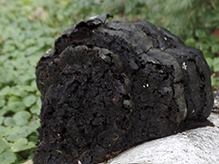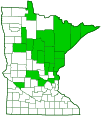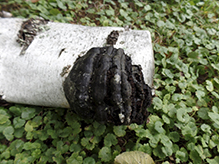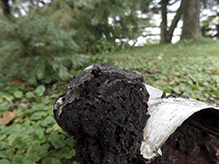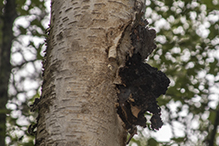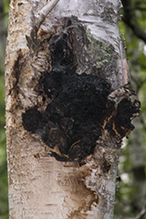Chaga
(Inonotus obliquus)
Conservation • Description • Habitat • Ecology • Use • Distribution • Taxonomy
Conservation Status |
|
|||||||
| IUCN Red List | not listed |
|||||||
| NatureServe | not listed |
|||||||
| Minnesota | not listed |
|||||||
Description |
||
Chaga is an easily recognized and often sought after fungus. It is found year round almost exclusively on the trunk of living paper birch and yellow birch trees. It also occurs on alder, beech, oak, and poplar, but does not produce the characteristic large outgrowth on those species. Fungal spores enter the living tree through wounds, especially branch stubs. The fungus is parasitic at this stage, obtaining its nutrients from the tree, and non-reproductive. It produces an irregular black mass (conk) that erupts through the bark and looks like charcoal. The conk is 4″ to 16″ long and wide and up to 2″ thick. The surface is dry, hard, and broken into cubes. Over time it becomes sunken in the middle. The interior flesh, if exposed, is tough, woody, and bright orangish-brown. Eventually, after 10 to 80 or more years, the infection will kill the tree. When that happens, the fungus produces a patch of whitish, fertile, fruiting bodies underneath the bark. At this stage the fungus us saprobic, obtaining its nutrients from decaying wood. |
||
Similar Species |
||
Habitat and Hosts |
||
Paper birch and yellow birch |
||
Ecology |
||
Season |
||
Year round |
||
Use |
||
Tea made from Chaga is purported to reduce inflammation, stimulate the immune system, protect the liver, and even to prevent and treat cancer. None of these effects have been confirmed in the laboratory. Like many alternative remedies, its effectiveness is probably directly proportional to the strength of user’s belief first that it will work and later that it has worked. |
||
Distribution |
||||
|
Sources |
|||
| 6/9/2022 | ||||
Occurrence |
||||
|
||||
Taxonomy |
|||
| Kingdom | Fungi (Fungi) | ||
| Subkingdom | Dikarya | ||
| Phylum | Basidiomycota (Basidiomycete Fungi) | ||
| Subphylum | Agaricomycotina (Higher Basidiomycetes) | ||
| Class | Agaricomycetes (Mushrooms, Bracket Fungi, Puffballs, and Allies) | ||
Order |
Hymenochaetales | ||
Family |
Hymenochaetaceae | ||
Genus |
Inonotus | ||
Synonyms |
|||
|
|||
Common Names |
|||
Chaga Chaga Mushroom |
|||
Glossary
Conk
A shelf-like, bracket-shaped fruiting body of certain fungi.
Parasitic
Obtaining nutrients from another living organism.
Saprobic
A term often used for saprotrophic fungi. Referring to fungi that obtain their nutrients from decayed organic matter.

Slideshows |
||

Visitor Videos |
|||
Share your video of this fungus. |
|||
| This button not working for you? Simply email us at info@MinnesotaSeasons.com. Attach a video, a YouTube link, or a cloud storage link. |
|||
Other Videos |
|||
| Foraging for Chaga (Inonotus obliquus) - www.returntonature.us ReturntoNatureSkills |
|||
About
Published on Feb 20, 2015 Heres a video on chaga mushrooms (Inonotus obliquus) highlighting identification aspects, ethical harvesting considerations, and aspects of its ecological signature, as well as medicinal and survival aspects of this wonderful mushroom. For more videos, articles, upcoming classes, and information visit www.returntonature.us and www.facebook.com/returntonatureskills For studies and research on the medicinal properties of chaga: |
|||
| Inonotus obliquus (Chaga): a mushroom threatened by commercial overharvesting ? Paul Stamets |
|||
About
Published on Sep 30, 2011 Chaga (Inonotus oblquus) grows slowly on beech and birch trees over many years. Chaga is a non-sporulating (non-fertile) hardened structure with a dark, cracked over-crust. Some mycologists call Chaga an above-ground sclerotium. Chaga grows on living trees, taking many years for a soft-ball size structure to form. Once the tree dies, a resupinate crust forms on the ground near the tree. This is the spore-reproducing structure. What scientists do not know is whether or not the removal of Chaga will harm the formation of the spore producing crust. We do know that wild harvesting of Chaga is radically reducing this species populations. And since we can grow mycelium -sustainably- while retaining its beneficial properties, please refrain from harvesting wild chaga for commercial purposes. Thank you. Respectfully, Paul Stamets (www.fungi.com) |
|||
| Chaga Mushroom ( Inonotus obliquus) in Singhampton, Ontario 2015 FISHWILD |
|||
About
Published on Dec 23, 2015 Found a beautiful Chaga Mushroom on a White Birch. This is one of the most medicinal mushrooms out there. Use it to make tea. |
|||
| Chaga Mushroom - Inonotus obliquus mlaskie |
|||
About
Published on Nov 28, 2016 Description |
|||

Created: 9/27/2018
Last Updated:
